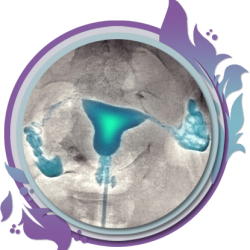A color photo of the uterus is usually taken to check if the fallopian tubes are open. In this procedure, after examination and placement (catheter) inside the cervix, the injection is performed and the patient is photographed at the same time as X-rays. color picture of the uterus helps to diagnose tubal disease and sometimes to diagnose intrauterine lesions.
Hysterosalpingography, or HSG, is a type of X-ray that is used to diagnose and see if the fallopian tubes are open and if the uterine cavity is normal. It takes less than 5 minutes to perform HSG, and it is usually done after menstruation and before ovulation.
How is hysterosalpingography performed?
A gynecologist or radiologist examines the patient’s uterus and places a Speculum inside the patient’s vagina. The cervix must first be cleaned and then a special device called a cervix cannula inserted into the cervix canal. In the next step, the iodine-containing fluid is infused into the uterus through the canola, and the uterine cavity is lethal to the iodine, which is seen as a white area on the sputum. It can be seen inside the uterus and fallopian tubes. Using this method, the length of the fallopian tubes and their openness can be determined if the contrast material settles into the abdomen from the end. Intrauterine anomalies can be identified by the treating physician while observing the passage of the contrast factor; Because uterine anomalies and uterine problems interfere with the movement of contrast material. HSG is not designed to assess the condition of the ovaries, diagnose endometriosis, and diagnose fibroids outside the endometrial cavity or inside the muscles of the uterus or outside the uterus. It is often achievable for the lateral view of the uterus by changing the position of the patient lying on the bed. After salingography, there are no restrictions on normal activities, although some doctors ask their patients not to have intercourse (sex) for a few days. It is not possible to assess the condition of the ovaries, endometriosis, fibroids with a color photo of the uterus.
Does hysterosalpingography increase the chances of fertility?
There is no consensus that hysterosalpingography increases the chances of fertility.
What are the risks and problems associated with HSG?
HSG is a very healthy diagnostic method and problems have been identified in less than 1% of cases:
Infection: The most common, known problem with HSG is infection. This problem is seen when the patient has suffered from previous tubal infections such as clomid infection. In rare cases, the infection causes damage to the fallopian tubes, which requires the cut of the fallopian tubes. The patient should inform his or her doctor when he or she experiences increasing pain and fever 1-2 days after HSG.
languishing, fainting: In rare cases, the patient may experience dizziness or confusion during or shortly after HSG.
Radiation exposure: The amount of radiation exposed to HSG is very low and less than the amount used in renal and intestinal tests. Even if the patient becomes pregnant in the same month, this exposure to radiation does not cause harm. HSG should not be performed if pregnancy is present.
Iodine sensitivity: In very rare cases, a patient may be allergic to iodine. If your patient is allergic to iodine, contrast-enhanced dyes, or seafood, they should tell their doctor. Women who are allergic to iodine should undergo HSG without a manual contrast agent. If the patient has itching, hives, or edema, they should tell their doctor.
Spotting: Spotting occurs 1-2 days after HSG. If a patient is bleeding profusely after HSG, they should tell their doctor.
What is the next step if the fallopian tubes are closed?
If the fallopian tubes are closed, your doctor may refer you to surgery through which the fallopian tubes can be seen directly.
Is there another option for assessing the clarity of the fallopian tubes?
If the fallopian tubes are open, laparoscopy can be considered. Using chromopertubation, an alternative procedure to check the clarity of the fallopian tubes is sonohysterosalpingography. For SHG, a container (thin tube) is inserted into the uterus through the vagina, and air and saline are infused into the uterus. In women with open fallopian tubes, small air bubbles are seen during ultrasound, along the fallopian tubes. However, this method is less valuable than HSG for assessing the clarity of uterine tubes.



